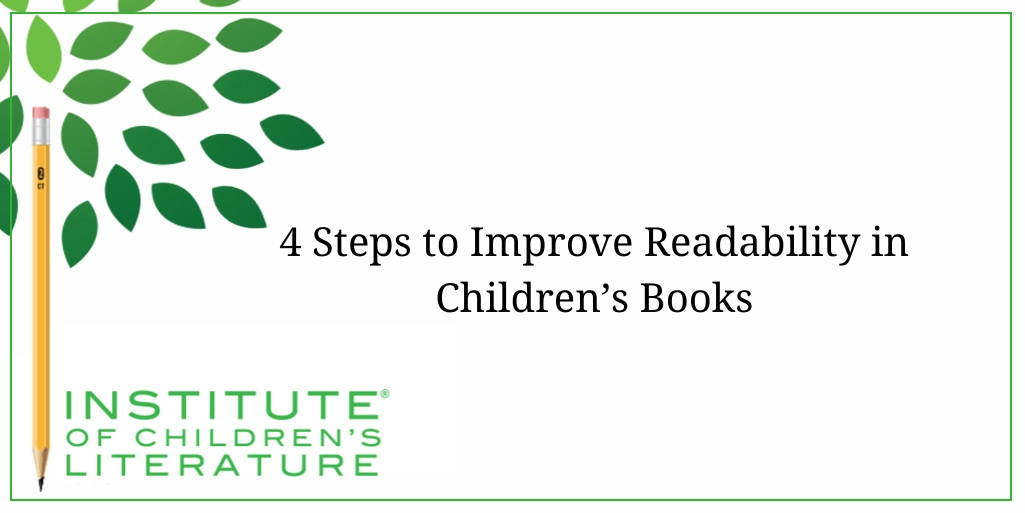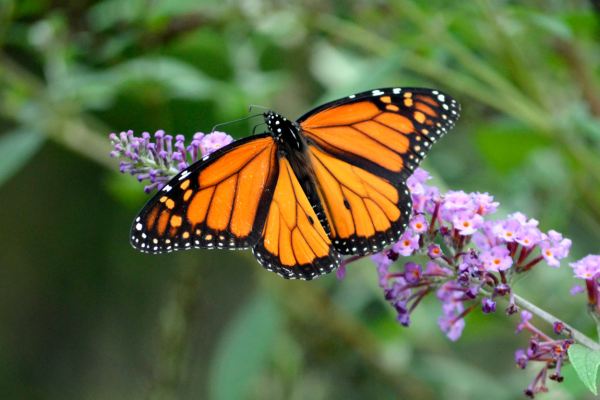
- Date: September 5, 2024
- Author: Jan Fields
- Category: Writing for Children Blog
- Craft, Educational, work for hire, Writing Craft
We teach our students how to write and get published!
View our Course Catalog >
4 Steps to Improve Readability in Children's Books
For kids, back to school means back to books. As writers, we are often part of the process of bringing books to these kids. And schools buy books based on how well they will work in a school setting. Part of writing books for children that can be used in a school setting lies in meeting the needs of the reader.
 Picture books, for example, tend to be read aloud by adults, and often in situations of limited time (or patience). As a result, picture books tend to have sentence structures and vocabulary that are too high for beginning readers. They don't need to be easy to read because they are read by adults. However, picture books are very short since they need to be read from beginning to end in one sitting.
Picture books, for example, tend to be read aloud by adults, and often in situations of limited time (or patience). As a result, picture books tend to have sentence structures and vocabulary that are too high for beginning readers. They don't need to be easy to read because they are read by adults. However, picture books are very short since they need to be read from beginning to end in one sitting.
With picture books, the focus of the writing technique itself is usually on how the text sounds, rather than how easy it is to sound out the words. In schools, picture books are often either read aloud by teachers or consumed by young children who “read” them by looking at the pictures and remembering the story that was previously read to them.
Books intended to be read independently by early elementary children are completely different. They'll need to match the reading skills of the reader since these children have had contact with far fewer texts and are still working on the job of reading. Not meeting their needs in the writing can result in a book that frustrates the reader and makes them dislike the whole process of reading.
That doesn't mean every moment of the reading needs to be easy. Challenge can be fun too, but it must be a surmountable challenge. Hard words need to be clear in meaning from the context in which they are used. Long sentences need to be surrounded by shorter sentences to avoid exhausting the young reader.
With these things in mind, it's worthwhile to think about readability at some point in your process (usually during the revision stage.) Sometimes you might even hold off until you get feedback from your test readers on whether the text was too hard, too easy, or about right.
The Process
What do you do if the text is too high or too low? Today, we’ll discuss four steps to help you raise and lower the reading level, (these steps do have a focus on how the readability apps often work, so some of them cater to the limits of apps).
 I use this process when I need to raise or lower the reading level of something I've written to meet the requirements of a publisher. This will be asked of you often if you're writing for the educational market but can also come in handy if you're writing early chapter books or other young reader materials for trade. If a publisher tells you the reading level is too high, they're asking for these kinds of fixes as well as for some global thought about reading ease.
I use this process when I need to raise or lower the reading level of something I've written to meet the requirements of a publisher. This will be asked of you often if you're writing for the educational market but can also come in handy if you're writing early chapter books or other young reader materials for trade. If a publisher tells you the reading level is too high, they're asking for these kinds of fixes as well as for some global thought about reading ease.
Step One: Vocabulary
1. You can use word lists to choose words from different grade levels – but know that some readability apps (such as the one that was built into Word) don’t use such lists and judge readability based on the length of the word. That means in some readability apps, “baseball” would score higher than “orb,” even though “orb” is a more obscure word. Still, overall, readability lists can be helpful, and you can find them online with a word search on grade-level reading lists.
2. Proper nouns raise the reading level on many leveling systems. This effect is lessened if the noun is used repeatedly. So, if you introduce a character, town name, or country, try to use the same one more than once.
- Though most automatic leveling apps can’t tell (so you’ll still get the hit from a high-level word, which you can usually explain to your editor), you can increase readability of difficult words by clear context cues or defining the word upon first use. Once you've introduced the word in context, using the word repeatedly will make it easier to read with each encounter. Even with common words, repeated use of the same word lowers reading level.
Step Two: Sentence Structure
- In general, shorter sentences level lower than longer sentences.If you need to lower the level, consider breaking long sentences up into more than one sentence. Keep in mind that many publishers for beginning readers don't like the use of sentence fragments. Some don't mind. Before you break up sentences to make them easier to read, be sure to know the preferences of your publisher on the issue of sentence fragments vs. always writing complete sentences.

- Direct sentences level lower (even if long). For example: “Joe went to the doctor in the morning” will level lower than “In the morning, Joe went to the doctor.” Another example: “The chicken ran across the yard flapping wildly” will level lower than “Flapping wildly, the chicken ran across the yard.”
- In general, the more commas your sentence contains, the higher your text will level.Also, other unusual punctuation (colons, semi-colons, dashes) will raise reading level. Keep in mind that many publishers will not allow unusual punctuation at all in early elementary material (my editors at ABDO for instance would not allow me to use semi-colons.)
- In general, the closer a sentence sounds to normal speech, the easier it is to read.Technical or very lyrical/literary choices make reading harder. This is another reason (along with vocabulary) that picture books often level very high even though they have so few words on a page and so few words overall.
Step Three: Paragraphs
Long paragraphs level higher than short paragraphs. This is why poetry and dialogue will often have lower reading levels when the reading level is measured by an app, even when the vocabulary is a higher level and the sentences are unusual. Since readers rest between paragraphs, short paragraphs can help readers when the material is quite challenging.
Step Four: Structure Choices
Think of this as a catch-all for many different choices that are less obvious but make a huge difference in ease of reading. For instance, clear organization increases reading ease in nonfiction. Clear transitions increase reading ease in nonfiction. Titles and headings used as signposts of organization increase reading ease in nonfiction. In fiction and narrative nonfiction, chronological order increases reading ease.
 Demands for background knowledge increase reading level in both nonfiction and fiction. Always think about what kinds of knowledge readers are likely to bring into the material that you are writing. For example, if your character encounters a butterfly in the rainforest, readers aren't going to struggle to understand what a butterfly is. They aren't going to trip over the word, even though it is relatively long. This is because butterflies are something children encounter from quite a young age and begin learning about in early elementary school.
Demands for background knowledge increase reading level in both nonfiction and fiction. Always think about what kinds of knowledge readers are likely to bring into the material that you are writing. For example, if your character encounters a butterfly in the rainforest, readers aren't going to struggle to understand what a butterfly is. They aren't going to trip over the word, even though it is relatively long. This is because butterflies are something children encounter from quite a young age and begin learning about in early elementary school.
However, if your character encounters a marmoset, the reader will be unlikely to bring much background knowledge to the encounter. They may not know what sort of animal a marmoset is. They are unlikely to be able to picture it without help. The writer will need to bring in more supporting information to avoid frustrating the reader.
In fiction, the number of characters overall and number of characters in each scene make the reading harder (reducing reading ease). This is especially true if the character names have strong similarities. It may strike you are charming to have two main characters named Missy and Missa, but that is going to require more thought from the reader to keep those two characters separate as they read.
Most readers can carry up to three characters in their heads with ease, but every time you add a character after that, you make the story more complex. If you need more characters, it can help to give them very different names and very different personalities, voices, and descriptions. Make them each distinct and interesting and you'll make them more memorable and therefore less confusing.
Abstract concepts increase reading difficulty. A book about dump trucks is considerably easier to read than a book about destiny, no matter how carefully you control the vocabulary or keep your writing direct. If you're going to write about abstract concepts, be sure to use clear examples, clear sentences, and age-appropriate approaches so the mechanics of reading the text don't compound the difficulty inherent in abstract concepts.
The Readability Bottom Line
Are you going to be asked to worry about your reading level very often? Probably not.
Many trade publishers don't think about reading level much when they are publishing. Instead of talking about your reading level, they'll question your voice if you use too many high-level vocabulary words. They'll remark on your pacing if you use too many long sentences and long, dense paragraphs.
These items affect readability, but they also make the material feel too adult and run the risk of boring the reader. So even if you never write for beginning readers, it's worthwhile to think a bit about what goes into the measure of reading level so that the writing you do matches the reader's age in tone, in pacing, and in ease of reading. You'll be surprised how much difference that makes to readers.
Related Articles
With over 100 books in publication, Jan Fields writes both chapter books for children and mystery novels for adults. She’s also known for a variety of experiences teaching writing, from one session SCBWI events to lengthier Highlights Foundation workshops to these blog posts for the Institute of Children’s Literature. As a former ICL instructor, Jan enjoys equipping writers for success in whatever way she can.




